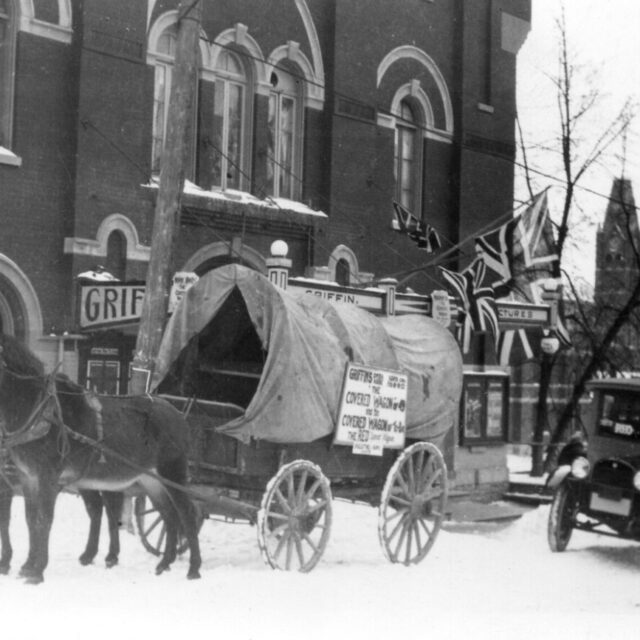
A Night at the Opera
Author: Connie Carson
Connie is a well-known local story-teller and professional who has a passion for the history of the City of Belleville, in particular, the downtown streets.
From 1883 to 1933 a deceptively and seemingly unassuming brick building solidly stood at the southwest corner of East Bridge Street and Church Street. It had been empty, neglected, and abandoned for several years and ultimately was demolished in 1933 and is now home to O’Flynn Weese Law Firm.
It has been said by some, that on a quiet evening while sitting on a front verandah in the old east hill area, one can still hear the muffled sounds of merriment coming from this mostly forgotten previous downtown entertainment center.
The Griffin Opera House, also known as the Belleville Opera House, the Carman Opera House, and Queen’s Opera Palace, became a shining beacon of light for Mr. John Griffin who went on to form the Griffin Amusement Company in 1906 and continued to dominate the music and theatre scene until 1922.
Notes from The Intelligencer in September of 1918 read;
“As a result of Mr. John Griffin’s visit to Belleville this week plans are being prepared for improvements to the Griffin Opera House. Lavatories will be installed and the heating system will be remodeled. Attention will also be paid to the ventilating of the theatre with a modern fan system to ensure the purity of the atmosphere at all times. Mr. Griffin is the moving spirit of the Griffin Amusement Corporation which controls a number of theatres.”
Mr. Griffin also owned the Palace Theatre on Front Street which sadly burned down in 1920. Actress Beatrice Lillie sang at the Palace Theatre as well as numerous other venues across the country. She was one of the last, and funniest of the silent film era and transitioned to movies and stage seamlessly. Her autobiography titled ‘Every OTHER Inch A Lady’ although not a literary success, is still one of my all-time favourite books.
The 1,300 seat theatre was said to have been built on an incline to give the auditorium and galleries unobstructed views for everyone. There was a 37 by 50 ft stage plus a lower level basement featuring a large hall, dressing rooms, and storage for stage props.
The costumes were dramatic and lavish, bright and gaudy as were the five-act plays that were performed nightly, and local lovers of music and musical drama came in droves to this garishly lit brick building overlooking the Belleville Armouries. They laughed along with traveling Minstrels on circuits through the area and cried while watching the melodramas such as Uncle Toms Cabin and Perils of Pauline on the silent screen.
At other times the audiences were enthralled by exciting Vaudeville acts and top tunes shows. An eclectic range of jugglers magicians and noted singers on their way to larger centers. plus military bands in full uniform and local talent alike were introduced from the stage at the Griffin Opera House in downtown Belleville.
For the regular price of .25 cents admission could be gained to Opera House for each show! Silent films were very popular at the turn of the century and welcomed new screen heroes such as Rudolph Valentino, Charlie Chaplin, and Clara Bow. Fans could not hear their favourite actors but they could now SEE them!
Artists and wealthy patrons alike mingled with guests at the chic openings and could forget about their troubles for a few magical hours.
The Roaring Twenties brought a whole new wave of excitement, money, and passion to the country with the addition of “The Talkies” and sound taking over the theatre business. It was also the beginning of the end for the silent film industry and for Mr. Jack Griffin as theatres closed and an important era of culture and entertainment shut its doors in our region.






